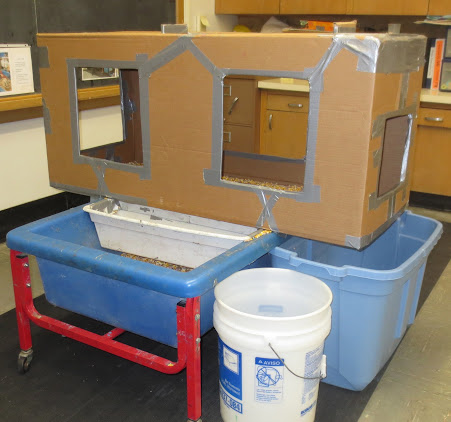Rocks were one of my favorite things to put in the sensory table. One reason was: I liked to bring natural elements into the classroom. Another reason was: rocks in my collection came in all shapes, sizes and colors. For example, some were porous; some were rough; some were smooth; some were heavy; some were surprisingly light; some were speckled; some had stripes. And another reason was: as a child, I just liked rocks. I would hunt for agates and, every chance I got, I would skip rocks across the water. (I still like rocks and skip them any time I get a chance.)
Here was an example of a variety of rocks that I exhibited on a table next to the sensory table. The rocks were there to explore and transport into the sensory table.
This set of rocks had many features to discover. However, let me highlight just a couple. There was a small gray rock that was smooth and had a round hole in it. The fossil rock also had a hole, however the shape was of a telltale snail not smooth and round like the one in the small rock. On the other hand, the volcanic rock had many holes and was quite rough. Most of the rocks, like the petrified wood, did not have holes.
By offering rocks in the sensory table, the underlying question was: What sense would the children make of them? Truth be told, there was no end to the sense the children made of the rocks as they explored their many features.
The rocks served as building material as one child stacked them in one corner of the sensory table.
That may sound simple, but because the rocks were smooth/slippery, different shapes and different sizes, that endeavor challenged his attempt to build higher and higher.
The little gray rock with the nice round hole became a scooping tool measuring just the right amount of sand onto the dustpan.
Another child created a bit of symmetry/art with the rocks by topping his birthday cake with rock "candles."
One child discovered that by striking two rocks together, she could spice up her concoction with a little bit of cinnamon.
Somehow she figured out that hitting the soft, reddish-brown rock against the harder rock resulted in tiny flecks that she saw as a special spice.
One child amazed himself by using one rock to draw lines on another rock. (Do I dare venture a guess that this was how early humans began the transition to written language?)
I have only scratched the surface of how children came to understand rocks, but let me give you one last example of a child making sense with rocks. This happened with a rock-query episode during which a child searched for rocks with specific attributes. I wrote it down in real time on a large post-it easel pad sheet that I taped to the wall next to the sensory table. S is the child and T is the teacher
The child began by looking for a "pretty big rock." She found what she was looking for but then began a new search for a different kind of rock. She again found what she was looking for: one that was "shiny, heavy and little.
I could point out that this was a spontaneous vocabulary exercise, but that was just a by-product of a natural conversation about finding the right kind of rock. That was true of the other examples, also. Children began to build their knowledge of rocks as a by-product of their experiences with the real rocks.
p.s. Some may be uncomfortable with rocks in their classroom. There may be an underling fear that children will throw the rocks. That may be a valid fear so it is important to know your children. If I thought a child might throw a rock, I would do one of two things: closely supervise the child or remove the rocks. However, that was so rare, I don't ever remember doing either of those interventions.
I believe that if children are given constructive ways to play with the materials in the sensory table, they will do so responsibly and in the process start to understand the materials and what they can do with them.
One child was very intentional fitting nine rocks into this jello mold. Wait! Are those square rocks in there? Is there such a thing as a square rock?




























